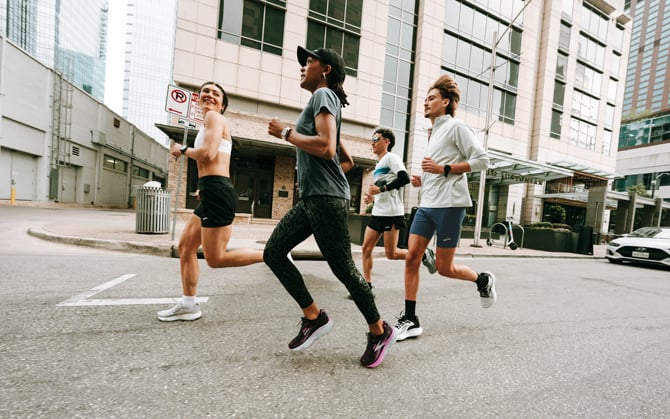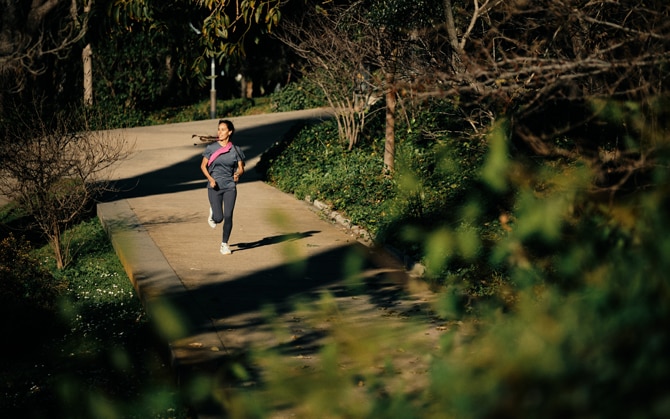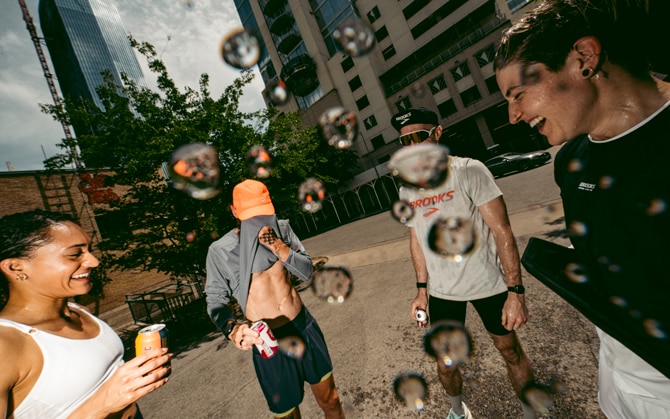Ask the running coach: running tips for beginners

If you’re a running newbie, you might think that getting started is as easy as putting one foot in front of the other.
However, there’s so much more to consider when you start taking running seriously as a sport or hobby. Knowing what shoes to wear, how to effectively warm up, and even how to fuel and nourish your body is key to avoiding injury and burnout. We’ve already listed out our top tips for beginner runners, but here, we chat to Steve Cardy on the eCommerce Merchandising team at Brooks Running – who is also a running coach – to find out everything every beginner runner should know before they step out.
- What are the most common beginner running mistakes?
- How to choose the best running shoes
- How do I stay motivated to run as a beginner?
- Do I need to warm up before running?
- What and when to eat before and after a run
- How to prevent running injuries
- How often should I run? Is it good to run every day?
- What is proper running form?
- How can I improve pace?
If you’re a seasoned sprinter, our Q&A for advanced runners might be more helpful for you.

Beginner and basics:
What are the most common beginner running mistakes?
"The two most common mistakes I see new runners make are trying to do way too much at once in the beginning. Improvement comes from consistency and intention — not just over days, but over months and years. Your cardiovascular system adapts faster than your bones, tendons, and ligaments do, so be patient. Understanding this early and including rest helps you train consistently and avoid injury.
The other is having no variation in training intensity. Meaning, they will go out and run at the same intensity on every run, or worse, they will just try to run harder every time they lace up. In the beginning, you may see some fast improvements if you’re lucky, but mostly runners doing this plateau very quickly, lose motivation, get injured, and at worst, quit the sport altogether.
Variation, with the correct distribution of different training intensities is key to developing as a runner."
How to choose the best running shoes
"Be sure to go to your local running store. Most top stores have at least one expert that can analyse your running gait and understand different risk factors, such as past injuries and sport history. This gives them a better picture of you as a runner, so they can recommend the shoes that will work best for you.
There are so many different shoe styles to choose from. Be sure to try on many different pairs to get an idea also of what you like the feel of. Our ‘Shoe Finder’ can help you get started on knowing what’s on offer, and what’s best suited for your needs. Try to combine your intuition with the advice of the expert – choosing the right running shoes is part advice, part feeling. There may be some trial and error in the beginning, so in the early stages tune in and listen to your body so you can narrow down on the things you like in a running shoe.
If you start taking running more seriously, a shoe rotation — shown to reduce injury risk — is key. Plus, it simply feels better to hit fast intervals in a lighter, more responsive shoe than in a daily trainer."
How do I stay motivated to run as a beginner?
"I believe it’s important to set trackable, visual goals. Meaning, if we take an arbitrary number, say 6’00” per kilometre in the beginning, take note of your average heart rate (HR). If this is ~140 bpm during a 30‑minute run, you should see improvements with consistent training. For example, after three months under the same conditions — track, weather and shoes — you notice your HR is now ~135 bpm. This is clear, visible progress.
You could apply this simple approach right through an intensity curve as, ultimately, we want to see improvement in baseline metrics and show how you raise your ceiling. Meaning, you can run faster paces, at a lower effort, which is running more economically."

Do I need to warm up before running?
"Ideally yes, if time allows. As it does for professional runners, a warm up consisting of light jogging, dynamic stretching, drills, and strides is commonplace before a mid to high-intensity session. It’s also best practice to raise the heart rate and core temperature, along with prepping the running specific muscles to fire. Yes, you read that correctly, warming up before running is important.
As beginners – or mortals, with full time jobs, family, and work commitments – time can be limited. In this case, you should aim to do 5 to 10 minutes of dynamic stretching, not static. Active, full-range joint movements help ease you into the early kilometres of your run. Evidence is also increasingly showing that static stretching before running can harm performance and so, in my view, should be avoided. If you do prefer static stretching, save it for after the run.
However, if you’re heading out the door and just don’t have the time for this, the first 10-15 minutes of your run should be gentle. Very gradually up your pace and try to settle into a rhythm fairly quickly."
What and when to eat before and after a run
"It's the answer no one likes but it depends – due to the complexities of the body. At lower intensities, like walking, we burn a higher percentage of stored fats. This is because our bodies need less oxygen and rely on fat stores and spare glycogen for fuel.
What matters is fuel for the work required, which is governed by the volume (how long) and the intensity (how hard you’re working out). As runners, though, it’s not only what you eat, but the quality of the food that matters. Eating largely unprocessed whole foods, rather than over processed and refined foods, matters.
That being said, simple sugars (including processed) which are easily digestible and fast acting carbohydrates, deliver energy to the working muscles faster which is necessary when working above certain intensities. This is where energy gels come in handy during a run.
When we start to exercise at higher intensities, we require more oxygen to do so and our fuel source splits, so the percentage of fat we’re burning alongside carbohydrate starts to shift. Glycogen is the bodies preferred energy source, and the harder we work, the more oxygen we need. Once we get to a certain intensity, the body burns almost only carbohydrate, with very little fat in the mix. This is also often why beginners often ‘hit the wall’ around the 20‑mile mark. At the intensity the runner is working at, if they don’t have a fuel strategy in place and haven’t been effectively consuming carbohydrate, their fuel stores are dwindling, and the body as a protective mechanism starts to change that fuel mix. This costs more oxygen to burn fat, and so our bodies slow down.
So, without overloading on the science, what’s the basics? If you’re going out first thing in the morning and you’ve eaten well the day before, you could go out and run easy without re-fuelling. If you do need to eat, then it’s simple: easy to digest is best. An hour before your run, you should focus on options like white toast with honey or jam, or a banana. Some runners can even do this 30 minutes before they head out, but again, it’s personal, and you should test this in training through trial and error to see what works for you.
Dr. Kyle Pfaffenbach, a professor in the Health and Human Performance programme at Eastern Oregon University and adviser to Brooks Beasts, offers his advice on what to eat before a race, and recommends incorporating your pre-race meals into your training sessions. “This will help you get used to the food and timing, and this approach fuels quality training sessions,” he explains.
If you have some more time before you head out, or, have a high intensity session planned, it will benefit you to up your intake of carbohydrates 3-4 hours before you hit the tarmac or track. In the morning this could mean a breakfast of oats, low fat milk, banana, and honey or a bagel or two, with honey or jam. If you were planning to go out mid-afternoon, you might want to eat some rice or pasta with a little sauce.
Post-run, be sure to refuel with a well-balanced meal with a 3:1 ratio of carbohydrates to protein within 60 minutes. While there is lots of research debating the timing of consumption to best support glycogen replenishment and protein intake, you should try and aim to eat within that timeframe to cover most of your needs. I often tell my athletes to prioritize the post training meal to support recovery and to be fuelled for the next session on the calendar. A good guideline here is 1-1.5g of carb per kg of body weight and 20-30g of protein to support muscle repair.
This could be a rice salad with lean protein, such as chicken or salmon, followed by some fruit. You could try a natural yogurt, like Skyr, which has 0% fat and is naturally high in protein, and accompany this with some fresh berries, fruit and a little granola."

How to prevent running injuries
"Too much too soon is the usual suspect in either volume (how much you run) or intensity (how hard). In runners of all levels, this can cause overuse injuries such as:
- Plantar fasciitis
- Medial tibial stress syndrome (shin splints)
- Patellofemoral pain syndrome (runners knee)
- Achilles tendinopathy
A missing piece which can aid both new and seasoned runners alike is strength training.
Strength training even two times a week can drastically reduce your injury rates. If you knew that your calf complex – specifically your soleus part of the calf complex – does most of the heavy lifting when running, you wouldn’t think twice about strengthening it. Similarly, if you know that your Achilles Tendon stores and releases energy like a spring to propel you forward, reducing load on your calves when strengthened and stiffened, you’d dedicate the time to working on it."
How often should I run? Is it good to run every day?
"I’m a big believer in minimum effective dose. What does this mean? The smallest dose of something – in this case, running – that will lead to improvement. Depending how you define improvement that is. Beginners do not need to run daily to see improvements, nor should they. As mentioned previously, there are a number of potential pitfalls and setbacks if you do too much too soon. In short, beginners can see gains by running just one to three times per week.
While there are advanced runners that run every day, it’s not uncommon for high level runners and elite runners to run double days, and it’s not uncommon for them to run 160-220km per week across 12-14 run sessions. Running sessions could span from strength training and mobility to cross training and other activities, like cycling and swimming. Just because you can though, doesn’t mean you should. Remember, your goal should be to do the minimum you can, whilst still seeing improvement, and minimizing your injury risk."
What is proper running form?
"This looks different for everyone, as we all have a unique running style. Looks aren’t everything, and sometimes what doesn’t look easy or graceful on the eye doesn’t mean that runner isn’t a very good economically and efficient runner. Running economy refers to how much oxygen you consume when you run at a given speed and is generally measured in a lab. As a rule, those who’ve trained longer, or run more, are more economical.
For beginners, try to focus on what feels good for you. Some basics could be running tall and leaning slightly forward, keeping your head up and looking straight ahead. Relax your shoulders, keeping them down and back to help your arm swing more naturally. Keep it simple, as trying to change too much from your natural running style can cost too much energy in the beginning. Focus on just getting out the door and developing running into a habit for life."
How can I improve pace?
"You can’t train what you don’t have. If you build up a quality, like top end speed, but you stop touching on it, you’ll lose it. Pace, or speed, is no exception to this rule. I’m not a fan of prescribing ‘the one thing’, but let’s do it: The one thing that helps many beginner runners work and maintain their top end speed is by adding strides to the ends of their runs. Strides are brief accelerations over 60-100m.
Adding a few of these, two to three at first, working up to five to eight, is a great way to touch on top-end speed without taxing yourself too much. Strides improve running economy, running form, and efficiency. Strides are a common practice among high-level and elite runners. Some elite runners, like Kenenisa Bekele of Ethiopia, are famous for taking this to the extreme and doing as many as 30 100m strides, post easy run."
Disclaimer: Our writer's advice is intended for informational or general educational purposes only. We always encourage you to speak with your physician or healthcare provider before making any adjustments to your running, nutrition, or fitness routines.
